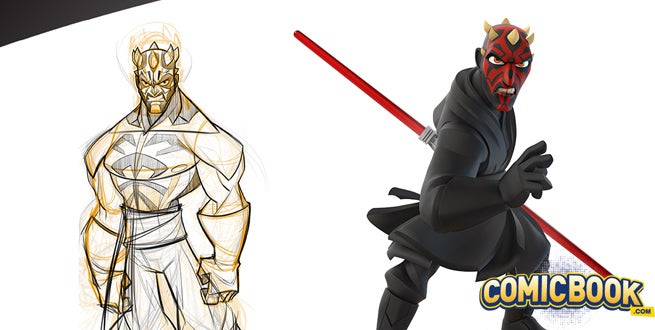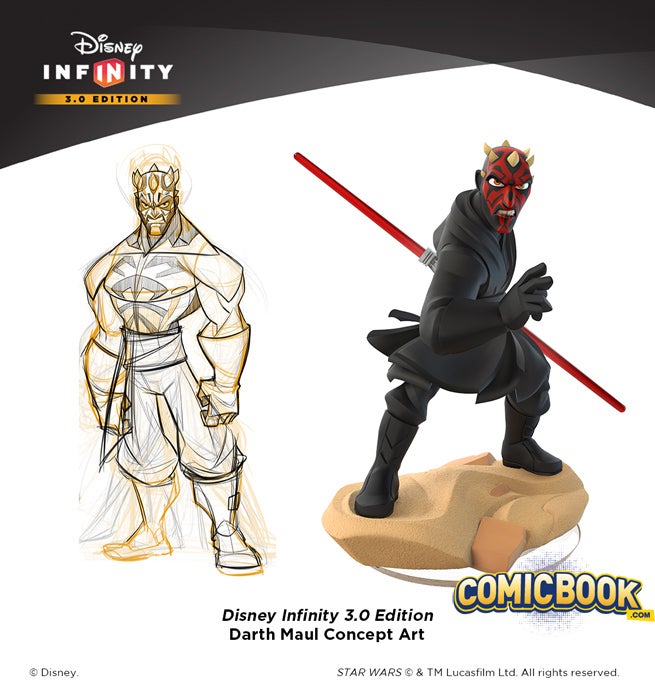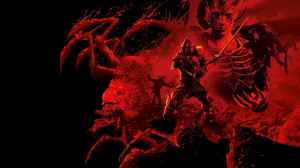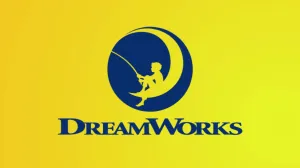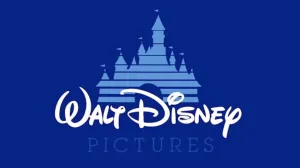Welcome back to MTFBWY, ComicBook.com’s ongoing column about everything Star Wars. Usually we split the focus of the column on two or more subjects, based on what’s going on in the Star Wars universe. But today, we have a special treat, as we delve into Disney Infinity 3.0’s Star Wars in a big way.
Videos by ComicBook.com
Unless you just finished honoring a vow of Internet-abstinence, you’ve heard that the next property coming to Disney Infinity with the 3.0 version this fall is Star Wars. Under the Disney umbrella, Disney Originals, Pixar, and Marvel Comics characters have all come into the toys-to-life game that has become a platform all its own, and the Jedi, Sith, and roguish heroes of a galaxy far, far away are next. The game will include play sets based on Clone Wars-era, Original Trilogy, and yes, even The Force Awakens, with characters representing each era of the franchise’s history.
In an exclusive conversation with ComicBook.com, Jeff Bunker, VP of Art Development at Disney’s Avalanche Studios gave us a peek behind the curtain at bringing Star Wars to Infinity. With an exclusive look at the first sketch for Darth Maul in tow, Bunker told us about how these characters evolve, the process of bringing a character design to both an animated form in-game and a still form as an actual plastic product, and the fun of having all these properties in one home.
Jeff, first off, when you found out the Star Wars rights were cleared and you guys were adding it in for 3.0 – what was the initial reaction, the very first thing you did?
Jeff Bunker: (laughs) What did I do? I could not believe it. When we first, stepping back a bit, Disney acquired our studio about 10 years ago, and just a couple months after that they bought Pixar. Now, we were excited to work on Disney properties alone, then with Pixar it was, “oh my word, this is crazy!” Then a couple years later they bought Marvel, and we though, “this can’t get any better!” Then, when they bought Lucasfilm and Star Wars it just blew our minds. We were all so excited about it.
When they told us they were open to it being part of Infinity, it was just the best thing ever. As an artist and a fan from the generation that came up with Star Wars it felt like being on top of a mountain
And what was the first thing you drew?
JB: Well, Yoda and Darth Vader were the two first ones that everybody went to.
The interesting challenge was when we started to go to characters like Luke, Han, and Leia, who had likenesses. We hadn’t really considered that at first. It’s a whole different type of challenge.
I think my favorite characters, other than Yoda, are still the villains. Darth Vader and Darth Maul are my favorites to draw.
I see–artists are usually drawn towards villains. Was there anything you went to immediately as a source for a look? Obviously with Marvel, you had the animated series to draw from; you have The Clone Wars and their slightly different dimensioned bodies to model after a bit, so did you look to them?
JB: Yeah, that’s an interesting thing – frankly, our style is quite similar to The Clone Wars. It’s funny, because Disney Infinity was started long before Disney bought Lucasfilm, and when we started coming up with the universal style for the game, we hadn’t considered Clone Wars as something to draw from. It wasn’t until we started working on characters like Ahsoka, and considering Darth Maul and Yoda that some of the big fans of the series in the studio said, “Well that’s almost exactly the Clone Wars looks!” That was after the fact, and we kind of backed into it! I know that’s surprising to people on the outside.
We definitely took inspiration from all the different places, even the early concept art from Ralph McQuarrie, and straight from the films.
With Darth Maul specifically, do you start on the in-game model or the figure first?
JB: It’s a funny thing that we went through – when we first started making Infinity, I’d been making video games already for 17 years. It was always a virtual character, and there’s so much you can get away with. So when we first started making real figures, we went really far in that direction. All we cared about was “how do we make this into a collector’s figure?”
Then we found out that some of those characters, after we had already sent them off to the factories to get made, that they really didn’t animate that well! (laughs) Then we swung in the opposite direction, and started worrying about the animation, and then the manufacturing would work.
So now we’re in a spot where we just make sure we address all the issues at once. We make sure that it animates well, and that we’re taking into consideration the manufacturing issues; it all comes up together.
So you have general concept art, then work from that in relation to both?
JB: Yes, and we will even look at rigs that these characters have to share – when you have so many characters, for both production and performance reasons, we have to share some animations and rigs, that type of thing. So we’ll start considering that early, and do concept art from that, too.
We let our artists start by going crazy and finding the right caricature and appeal at first, then we start reining them in and figure out how we make it work with our constraints.
I’m looking at the initial concept art alongside the actual figure. The sketch I have of concept art shows a beefier (and shirtless) Maul than people may be used to, and certainly more so than what the figure wound up being – what was the evolution there?
JB: Yeah, that’s funny. Like I just mentioned, a lot of times we start creating caricatures of the characters based off our impressions of that character. So when we started off with Darth Maul, we thought about how intimidating and powerful he was as a character, and that impression that we wanted to give of his essence showed up in those sketches. It wasn’t until we started sending those to Lucasfilm that they said, “You know, Ray Park was actually pretty small.” And he is, he’s not a big guy at all. When we really started paying attention to what he was in the film we saw how crazy we went there.
At the same time, it was still good to start there, because we figured out the presence and intimidation in the way that he stands and presents himself. We toned the muscles down, but we learned things from those early explorations that found their way into the final product for sure.
What did you learn from making the Marvel models that you were able to apply to the Star Wars models?
JB: It was actually very fortuitous that we did Marvel first. When we started working on Infinity 1.0 and just working with Disney and Pixar characters, we just for fun were playing around with doing characters from outside of Disney to see if our style worked across different brands.
Before Disney had bought Marvel, we played around with Captain America and a couple other Marvel characters!
So we thought we had created a style at the very beginning that already worked for everything.
Then, when we started working with [Marvel CCO] Joe Quesada and the artists at Marvel, it became apparent that what we thought we had was not right for Marvel. It took the super hero out of them and made them a little to comedic and cartoony. It was really enlightening and fun to figure out how to take what we’d learned on Infinity 1.0 and bring these Marvel characters into it, but still have them feel heroic and aspirational.
You’ve seen where we ended up, and I think we ended in a good spot. They’re not comical versions of the characters, they’re pretty cool looking! We added more anatomy into it to make them more muscular, and that broadened our design box to the point that when we wanted to do Star Wars, we had already found a lot of answers we could apply to it from Marvel.
Yeah, I’ve spoken with John Vignocchi before about the sense of anticipation you guys found for the Marvel figures. I see that in the Darth Maul figure, where he’s about to jump out and start spinning his lightsaber.
JB: Exactly. We really try to, like JV said, we don’t want our figures to feel like they’re in mid-action, we want them to feel like they’re in anticipation of action. That allows us, too, to create a story or a scene across each group. We really want the families of figures to work well together; a great example is what we did with the Avengers and the PlayStation-exclusive display with the Frost Beast. They all looked like they belonged in that scene together, and I think you can do that much easier if you have these poses in anticipation of action. It works really well with the Lucasfilm characters because we are very inspired by the scenes from the movies. If you scrub through the scenes, you can find – maybe not exactly the pose each figure is in, but frames that for sure inspired the direction that we went.
With the tattoos and the horns, it seems like a lot of work went into Darth Maul. What was the most difficult part in “Infini-tizing” the character?
JB: You know, he was actually very easy and fun to design in 2D (laughs). As soon as we had to make him real? He was a huge challenge, probably our biggest challenge to make a character into a figure. The things they’ve engineered into his model are incredible.
Every one of those horns on his head is a unique piece of plastic that they have to assemble.
Oh, really?
JB: Yeah, each one is a tiny individual piece. I haven’t been there to see the assembly happen, but it’s incredible. They can’t paint the tattoos with the horns there, they can’t get to it cleanly, so they’re applied after the fact. Then even to get an accurate, just clean paint job on the tattoos is an amazing amount of engineering that we worked really hard with the team in China, and I’m really pleased with how it turned out.
There are also incredible layers of cloth in his robes. There’s an amazing number of pieces that go into making Maul’s figure.
So, obviously, there are Disney collectors and Marvel collectors, but Star Wars collecting is unique unto its own. There are places like Rancho Obi-Wan where you have an actual museum of collected toys and memorabilia, you have magazines, and books, and movies just about the collecting of Star Wars toys. How closely did you consider the Star Wars completionists, who are going to put these alongside their classic Kenner and Hasbro figures?
JB: It’s funny, because when we work on a character, no matter which one it is, we work very closely with the creator or actor or owner of that character to try to make them happy. As we’re working with them, it doesn’t matter which character it is, that character becomes our most important character in the world. We take it really seriously and care a lot about the quality and approach to it.
On the other hand, when you work on a character like Yoda, Darth Maul, Darth Vader, or even Chewie, there’s a different level of fandom there. We definitely felt some pressure to make those fans happy.
The good news for us, is that Lucasfilm knows what they’re doing; they’ve been doing this for awhile! They were able to steer us in some really good directions and give us great advice throughout the process. In the past, we’ve discovered that when we’re making the filmmakers or the creators happy, then we make the fans happy. We’re pretty confident, and the team at Lucasfilm said they’re very happy with what we ended up with. I think the fans will be liking it, too.
Any final thoughts on your inclusion in the Disney family?What has it been like working with all these sister companies and branches that are part of Disney now?
JB: You know, we’re in such a unique position, that sometimes I have to pinch myself – you think about it, and not just in the broad terms of oh yeah, I get to work with Pixar and Marvel and Lucasfilm… You go down a level and I get to work with John Lasseter on Toy Story. I get to work with Ronnie Del Carmen on Inside Out. I get to work with Joe Quesada at Marvel. You talk about the individuals that I get to work with based on this property, and Infinity has opened all these doors and partnerships. It really boggles the mind!
Then to add on top of that, as Disney Infinity started getting bigger than Avalanche could handle, we started tapping some partner studios that we admired for the work they do, and see if they could enhance the game we were making. So we went to Ninja Theory, who did Devil May Cry and Heavenly Sword, and we went to Gobo for their great vehicle stuff, and Sumo; we have all these partnerships with these and other development studios that have been really fun to work with.
It’s just crazy, all these different people that we get to interact with in a creative way, it’s really incredible. There really hasn’t been a bad experience. Everyone has been really helpful and great to work with.
And of course, you got to work on The Force Awakens stuff before anyone else even knows what the movie’s about…
JB: (laughs) You know, I don’t know if that’s a good thing or not!
It’s really strange to be in the know on something like that, especially when you know how badly people are trying to dig to get information. That was actually a pretty easy secret to keep, it was too scary to do otherwise.

